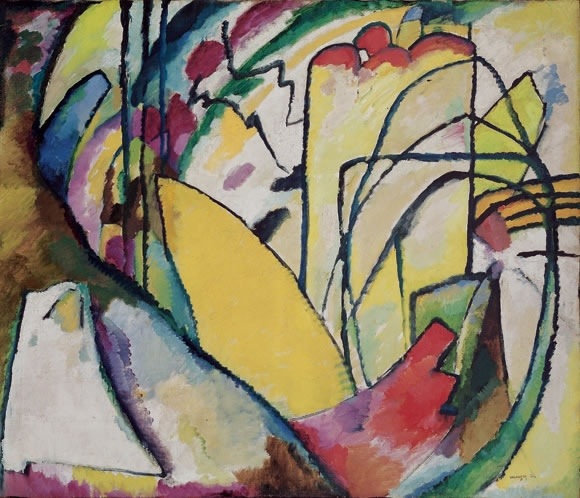“IMPROVISATION 10, 1910”, by Wassily Kandinsky, image courtesy of Fondation Beyeler, photo by Peter Schibli, Basel
“In each artistic circle are thousands of such artists, of whom the majority seek only for some new technical manner, and who produce millions of works of art without enthusiasm, with cold hearts and souls asleep.” – Wassily Kandinsky
Following are quotes pulled from a re-read of Concerning the Spiritual in Art, by Wassily Kandinsky. Published in 1911, the book contains ideas that seem urgent even 100 years later.
In a time when the material is worshiped, where it obfuscates intention and wrecks havoc on our souls, a revisit to the spiritual aspect of things seems in order. My mentors have given workshops for the past several years on the spiritual in art, as they always have their fingers on the pulse of the time vis a vis the arts, and indeed have recognized this dire need of focus.
What does it mean to go about making and experiencing art in a feeling and not a calculating way/intellectual way? A way with awareness and consciousness. Using it as a vehicle to communicate inner needs, which however isolated and personal this sounds is actually a universal concept. Private worlds show common problems.
Kandinsky writes beautifully on the topic of the spiritual in art, so I will not paraphrase, but simply list some of the jewels I found this current re-read. The book is available online for free with the Gutenberg Project, enjoy. That which you put your attention on does grow stronger.
Tagged: Concerning the Spiritual in Art, Wassily Kandinsky“So we see that a deliberate search for personality and “style” is not only impossible, but comparatively unimportant. The close relationship of art throughout the ages, is not a relationship in outward form but in inner meaning. And therefore the talk of schools, of lines of “development”, of “principles of art,” etc, is based on misunderstanding and can only lead to confusion.”
“The spectator is too ready to look for meaning in a picture – i.e. the same outward connection between its various parts, Out materialilstic age has produced a type of spectator or ‘connoisseur’, who is not content to put himself opposite a picture and let it say its own message. Instead of allowing the inner value of the picture to work, he worries himself in looking for ”closeness to nature”, or “temperament”, or “handling”, or “tonality” or “perspective” or whatnot. His eye does not probe the outer expression to arrive at the inner meaning.”
“At present time any attempt to define this new art would be as useless as pulling a small bud open so as to make a fully blown flower.”
“If the artist be the priest of beauty, nevertheless this beauty is to be sought only according to the principle of the inner need, and can be measured only according to the size and intensity of that need.”
“Painting is an art, and art is not vague production, transitory and isolated, but a power which must be directed to the improvement and refinement of the human soul-to, in fact, the raising of the spiritual triangle…..It is very important for the artist to gauge his position alright, to realize that he has a duty to his art and to himself, that he is not king of the castle but rather a servant of a nobler purpose. He must search deeply into his own soul, develop and tend to it, so that his art has something to clothe, and does not remain a glove without a hand.”
“That art is above nature is no new discovery. New principles do not fall from heaven, but are logically connected with past and future……The harmony of the new art demands a more subtle construction than this, something that appeals less to the eye and more to the soul. This “concealed” construction may arise from an apparently fortuitous selection of forms on the canvas. Their external lack of cohesion is their internal harmony.”
“White, therefore, has this harmony of silence, which works upon us negatively, like many pauses in music that break temporarily the melody. It is not a dead silence, but one pregnant with possibilities. White has the appeal of the nothingness that is before birth, of the world in the ice age.”
“The artist must be blind to distinctions between “recognized” or “unrecognized” conventions of form, deaf to the transitory teaching and demands of his particular age. He must watch only the trend of the inner need, and hearken to its words alone. Then he will safely employ means both sanctioned and forbidden by his contemporaries. All means are sinful which obscure that inner need. ”
It is impossible to theorize about this ideal of art. In real art theory does not precede practice, but follows her.”
“In each artistic circle are thousands of such artists, of whom the majority seek only for some new technical manner, and who produce millions of works of art without enthusiasm, with cold hearts and souls asleep.”

1 Comment
zac • August 19, 2013
This is a really good read personally. Must agree that you are one of several coolest doodlekit I actually saw. Appreciate your posting this useful information. This was what exactly I was on looking for. I'm going to come back to this web site for sure!
Would you like to share your thoughts?